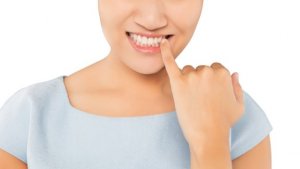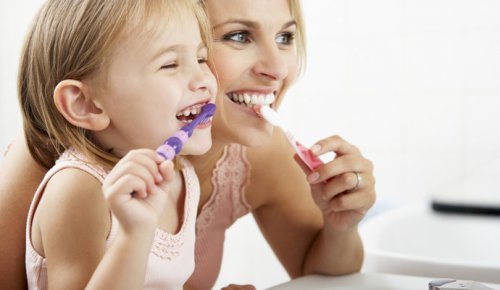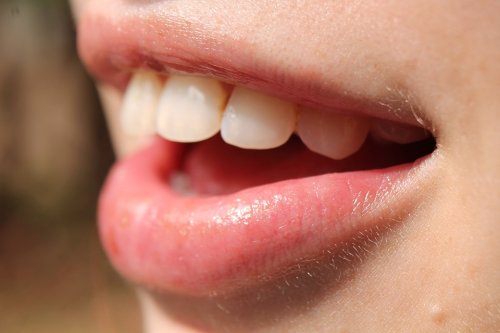Why Do Teeth Change Color?

Over the course of our lives, we may notice that our teeth change color. We don’t always pay attention to this because we think it has to do with changes related to normal growth and development. However, there is much more to it than that.
Today, we want to talk about why teeth change color and what you can do to prevent it.
The appearance and characteristics of teeth
The first teeth that come in – also known as baby teeth – start to cut through the gums when babies are about 5 months old. Of course, this can vary, and teeth will show up later for some babies. In total, humans have 20 teeth: ten located in the upper part of their mouths and ten on the bottom.
These 20 teeth fall into several categories. Incisors are the most visible teeth in the mouth, located at the front. Cuspids, or canines, are located behind the incisors. In the back of the mouth are the molars. Between the ages of six and eight, three or four molars will appear.
These molars don’t move, which means they’re more prone to cavities and notable color changes. At this age, a child’s baby teeth also fall out, followed by the appearance of permanent teeth.
Wisdom teeth can appear at any moment – there is no specific age. Their arrival tends to be painful, as they move due to lack of space. The worst part is that they usually need to be removed by a specialist, since they serve no real purpose.
All teeth are made up of that which is visible, the crown, and a part that is invisible, which is the root. Roots are immersed in sockets in the gums which are called dental alveolus.

Why do teeth change color?
There are numerous factors that can lead to changes in the color of teeth. Below you’ll find a list of the most common causes:
Trauma
Many times, teeth change color as a result of falls and bumps. This is especially true for the front teeth. In general, they may turn grey, brown or dark yellow.
Cavities
A lack of proper dental hygiene or improper use of a toothbrush can cause teeth to become darker in color. This is due to the existence of calcified bacteria – more commonly known as cavities – that form in teeth.
One of the most dangerous consequences of the presence of cavities is the complete loss of affected teeth.
Foods and medications
Some foods with a high content of colorants – like soft drinks and condiments – or that have a high iron content can lead to the staining of teeth. The residue that these substances leave behind remain on the teeth for some time, which makes them difficult to eliminate.
Tobacco
Cigarettes tend to cause unsightly stains on a person’s teeth. This is due to their high nicotine content and the smoke that enters the mouth.
Smokers cause serious damage to their teeth, and this goes far beyond their color. Smoking also reduces the flow of blood towards the gums, which makes them more prone to periodontal diseases.

“A lack of proper dental hygiene or improper use of a toothbrush can cause teeth to become darker in color.”
Tips for preventing changes in color
It’s always better to prevent than to treat. That’s why we suggest these simple methods for keeping your teeth from changing their color:
- Use all of your teeth to chew. This is the only way to strengthen your gums.
- Eat an apple before you go to bed, being sure to chew it well. You can even do so after you’ve brushed your teeth.
- Avoid excessive consumption of candies and sweets in general. These contribute to the formation of cavities and, therefore, changes in the color of teeth.
- If you’re a frequent smoker or tobacco user, rub a leaf of fresh sage on your teeth or a cotton ball soaked in hydrogen peroxide.
- Hydrogen peroxide is one of the best toothpastes. You can add it to your toothbrush to maximize its whitening effect. Sodium perborate is the same substance, but in powder form. However, you should only use it under the supervision of your dentist.
- Teeth change color when we fail to use our toothbrush properly. In this sense, you should actually have two tooth brushes. You can use one dry in order to clean your mouth, and then use the other with toothpaste.
The factors that can cause our teeth to change color are very common. So much so that we don’t always pay attention to them and we mistreat our teeth on a daily basis.
It’s important to practice good oral hygiene on a daily basis. This isn’t just a question of aesthetics. In fact, lack of proper oral hygiene can have negative implications on our health in general.
Over the course of our lives, we may notice that our teeth change color. We don’t always pay attention to this because we think it has to do with changes related to normal growth and development. However, there is much more to it than that.
Today, we want to talk about why teeth change color and what you can do to prevent it.
The appearance and characteristics of teeth
The first teeth that come in – also known as baby teeth – start to cut through the gums when babies are about 5 months old. Of course, this can vary, and teeth will show up later for some babies. In total, humans have 20 teeth: ten located in the upper part of their mouths and ten on the bottom.
These 20 teeth fall into several categories. Incisors are the most visible teeth in the mouth, located at the front. Cuspids, or canines, are located behind the incisors. In the back of the mouth are the molars. Between the ages of six and eight, three or four molars will appear.
These molars don’t move, which means they’re more prone to cavities and notable color changes. At this age, a child’s baby teeth also fall out, followed by the appearance of permanent teeth.
Wisdom teeth can appear at any moment – there is no specific age. Their arrival tends to be painful, as they move due to lack of space. The worst part is that they usually need to be removed by a specialist, since they serve no real purpose.
All teeth are made up of that which is visible, the crown, and a part that is invisible, which is the root. Roots are immersed in sockets in the gums which are called dental alveolus.

Why do teeth change color?
There are numerous factors that can lead to changes in the color of teeth. Below you’ll find a list of the most common causes:
Trauma
Many times, teeth change color as a result of falls and bumps. This is especially true for the front teeth. In general, they may turn grey, brown or dark yellow.
Cavities
A lack of proper dental hygiene or improper use of a toothbrush can cause teeth to become darker in color. This is due to the existence of calcified bacteria – more commonly known as cavities – that form in teeth.
One of the most dangerous consequences of the presence of cavities is the complete loss of affected teeth.
Foods and medications
Some foods with a high content of colorants – like soft drinks and condiments – or that have a high iron content can lead to the staining of teeth. The residue that these substances leave behind remain on the teeth for some time, which makes them difficult to eliminate.
Tobacco
Cigarettes tend to cause unsightly stains on a person’s teeth. This is due to their high nicotine content and the smoke that enters the mouth.
Smokers cause serious damage to their teeth, and this goes far beyond their color. Smoking also reduces the flow of blood towards the gums, which makes them more prone to periodontal diseases.

“A lack of proper dental hygiene or improper use of a toothbrush can cause teeth to become darker in color.”
Tips for preventing changes in color
It’s always better to prevent than to treat. That’s why we suggest these simple methods for keeping your teeth from changing their color:
- Use all of your teeth to chew. This is the only way to strengthen your gums.
- Eat an apple before you go to bed, being sure to chew it well. You can even do so after you’ve brushed your teeth.
- Avoid excessive consumption of candies and sweets in general. These contribute to the formation of cavities and, therefore, changes in the color of teeth.
- If you’re a frequent smoker or tobacco user, rub a leaf of fresh sage on your teeth or a cotton ball soaked in hydrogen peroxide.
- Hydrogen peroxide is one of the best toothpastes. You can add it to your toothbrush to maximize its whitening effect. Sodium perborate is the same substance, but in powder form. However, you should only use it under the supervision of your dentist.
- Teeth change color when we fail to use our toothbrush properly. In this sense, you should actually have two tooth brushes. You can use one dry in order to clean your mouth, and then use the other with toothpaste.
The factors that can cause our teeth to change color are very common. So much so that we don’t always pay attention to them and we mistreat our teeth on a daily basis.
It’s important to practice good oral hygiene on a daily basis. This isn’t just a question of aesthetics. In fact, lack of proper oral hygiene can have negative implications on our health in general.
All cited sources were thoroughly reviewed by our team to ensure their quality, reliability, currency, and validity. The bibliography of this article was considered reliable and of academic or scientific accuracy.
- Joiner A. Tooth colour: a review of the literature. J Dent. 2004; 32 (suppl): 3-12.
- Morales G, M. (1972). Enciclopedia del hogar (Tomo II). 11th ed. Barcelona-España: Ediciones Garriga, S.A., p.60.
- Moradas M, Álvarez B. Manchas dentales extrínsecas y sus posibles relaciones con los materiales blanqueantes. Avances en Odontoestomatología. Vol 34 (2), 2018.
- Russell MD, Gulfraz M, Moss BW. In vivo measurement of colour changes in natural teeth. J Oral Rahabil 2000; 27: 786-92.
This text is provided for informational purposes only and does not replace consultation with a professional. If in doubt, consult your specialist.








